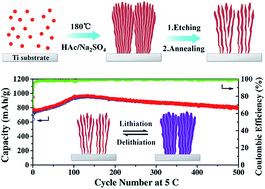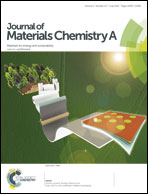Robust α-Fe2O3 nanorod arrays with optimized interstices as high-performance 3D anodes for high-rate lithium ion batteries†
Abstract
Self-supported α-Fe2O3 nanorod arrays consisting of mesocrystalline nanorod bundles with tunable interstices were prepared by solution-phase growth coupled with chemical etching. The existence of acetic acid and sulfate ions in the hydrothermal system promoted the direct growth of α-Fe2O3 nanorod bundles with a mesocrystalline structure on a Ti substrate. The robust α-Fe2O3 nanorod arrays with optimized interstices are able to offer reduced lengths for electron transport and ion diffusion, and enough spaces to accommodate lithiation-induced volume expansion, leading to novel three-dimensional (3D) anodes with significantly improved rate capability and cyclability. When used as binder-free anodes for lithium ion batteries (LIBs), the α-Fe2O3 nanorod arrays retained a reversible capacity of 801 mA h g−1 after 500 cycles at 5 C (namely, 5 A g−1), and achieved practically valuable capacities of 499 mA h g−1 and 350 mA h g−1 at high rates of 20 C and 30 C, respectively. Furthermore, a flexible full battery with high capacity and fast charging capability was assembled using the α-Fe2O3 nanorod arrays as the anode, demonstrating their potential applications in flexible electronic devices.



 Please wait while we load your content...
Please wait while we load your content...